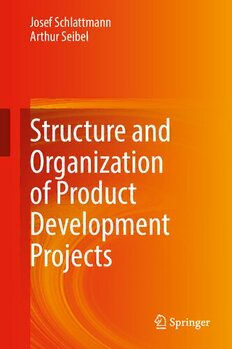Table Of ContentJosef Schlattmann
Arthur Seibel
Structure and
Organization
of Product
Development
Projects
Structure and Organization of Product Development
Projects
·
Josef Schlattmann Arthur Seibel
Structure and Organization
of Product Development
Projects
JosefSchlattmann ArthurSeibel
WorkgrouponSystemTechnologies FraunhoferResearchInstitutionfor
andEngineeringDesignMethodology AdditiveManufacturingTechnologiesIAPT
HamburgUniversityofTechnology Hamburg,Germany
Hamburg,Germany
ISBN978-3-030-81045-0 ISBN978-3-030-81046-7 (eBook)
https://doi.org/10.1007/978-3-030-81046-7
Translation from the German language edition: Aufbau und Organisation von Entwicklungsprojekten
byJosefSchlattmann,andArthurSeibel,©Springer-VerlagGmbHDeutschland2017.Publishedby
Springer-VerlagGmbHDeutschland.AllRightsReserved.
©TheEditor(s)(ifapplicable)andTheAuthor(s),underexclusivelicensetoSpringerNatureSwitzerland
AG2021
Thisworkissubjecttocopyright.AllrightsaresolelyandexclusivelylicensedbythePublisher,whether
thewholeorpartofthematerialisconcerned,specificallytherightsoftranslation,reprinting,reuse
ofillustrations,recitation,broadcasting,reproductiononmicrofilmsorinanyotherphysicalway,and
transmissionorinformationstorageandretrieval,electronicadaptation,computersoftware,orbysimilar
ordissimilarmethodologynowknownorhereafterdeveloped.
Theuseofgeneraldescriptivenames,registerednames,trademarks,servicemarks,etc.inthispublication
doesnotimply,evenintheabsenceofaspecificstatement,thatsuchnamesareexemptfromtherelevant
protectivelawsandregulationsandthereforefreeforgeneraluse.
Thepublisher,theauthorsandtheeditorsaresafetoassumethattheadviceandinformationinthisbook
arebelievedtobetrueandaccurateatthedateofpublication.Neitherthepublishernortheauthorsor
theeditorsgiveawarranty,expressedorimplied,withrespecttothematerialcontainedhereinorforany
errorsoromissionsthatmayhavebeenmade.Thepublisherremainsneutralwithregardtojurisdictional
claimsinpublishedmapsandinstitutionalaffiliations.
ThisSpringerimprintispublishedbytheregisteredcompanySpringerNatureSwitzerlandAG
Theregisteredcompanyaddressis:Gewerbestrasse11,6330Cham,Switzerland
Preface
Productdevelopmentprojectsdonotnecessarilyhavetobecomplexiftheyarestruc-
turedandorganizedintherightway;however,theyoftenbecomecomplexwhentheir
manageabilityreachesnaturallimitsorwhencoordinationandprojectmanagement
issuesarenotclearlydefinedandcomprehensibleforallpartiesinvolved.Inaddition,
leadershipofemployeesaswellasprojectsmustbelearned;otherwise,itisusually
lefttocoincidence,andinmostuniversityeducationcourses,itstillcomesupfartoo
short.
The structure of this handbook is based on the organization and process of a
productdevelopmentproject,suchasthosefoundinmedium-sizedmechanicalengi-
neeringcompanies.Theorganizationconcernsallareasdirectlyinvolvedfromthe
idea to the marketable product and includes all the necessary steps (methodical
procedure)aswellastheassociatedexecutingbodiessothattheorganizationcanbe
describedasasysteminitsentiretyandthecorrespondingprocessassystematic.
Therearemanymethodicaltoolsandguidelinesforasystematicapproach.The
mainadvantagesofusingsuchanapproachare,amongothers:
(cid:129)
Thedesignprocessinparticularcanbebettermanaged.
(cid:129)
Themethodscanbeusedastoolstosignificantlysupportproductdevelopment.
(cid:129)
Agoal-orientedapproachcreatesthenecessaryfreedomforcreativeaction.
(cid:129)
The expansion of pattern formation, and especially the promotion of employee
creativity,increasestheprobabilityofcreativeleaps.
Consequently,theimportanceofasystematicapproachtoproductdevelopment
cannotbeoverestimated.
This handbook would like to bring methods proven in industrial practice and
taughtinnumerouslecturesandseminarstoalargeraudiencetomaketheinnovation
workoftheproductdevelopersubstantiallymoreeffective,particularlyinsmall-to
medium-sized mechanical engineering companies. The decisive factor here is the
insightthatnewproductsarenotsimplygeneratedby“designing”and“organizing”
butare created by people, sincebehind the technical difficulties,there are,infact,
always hidden human problems that cannot be overcome by functional measures
alone.
v
vi Preface
To avoid disrupting the flow of reading, we have deliberately omitted the addi-
tionalformulationoffemalepronouns.Wewouldthereforeliketopointoutthatthe
exclusiveuseofthemasculineformshouldofcoursebeunderstoodasindependent
ofgender.
WewouldliketotakethisopportunitytothankProf.Dr.-Ing.WalterJorden,the
formerheadoftheLaboratoryforEngineeringDesignattheUniversityofPaderborn,
onwhose“PaderbornDesignSchool”thishandbookislargelybased.Wewouldalso
liketothankthepublishinghousefortheexcellentcooperationandprintingofthis
handbook.
Hamburg,Germany JosefSchlattmann
Spring2021 ArthurSeibel
Contents
IntroductiontoProductDevelopment ............................... 1
1 GeneralInformation ............................................. 1
2 NeedforRapidDevelopment ..................................... 5
3 ProductDevelopmentProcess ..................................... 8
3.1 PlanningPhase ............................................. 8
3.2 DesignPhase .............................................. 9
3.3 ElaborationPhase .......................................... 9
References ........................................................ 10
FundamentalsofProductPlanning .................................. 11
1 GeneralInformation ............................................. 11
1.1 IntroductionandDelimitation ................................ 11
2 MarketBehavior ................................................ 12
3 SearchforNewProducts ......................................... 14
3.1 SearchFields .............................................. 14
3.2 Diversification ............................................. 16
4 ImprovementofExistingProducts ................................. 17
4.1 ValueAnalysis ............................................. 17
4.2 ABCAnalysis ............................................. 18
4.3 Function–CostMatrix ....................................... 19
References ........................................................ 21
OrganizationofaProductDevelopmentArea ........................ 23
1 OrganizationalStructure ......................................... 23
1.1 StructureofaCompany ..................................... 23
1.2 StructureofaProductDevelopmentArea ...................... 24
1.3 GuidingRules ............................................. 26
2 ResponsibilityandCommunication ................................ 27
2.1 LineandMatrixOrganization ................................ 27
2.2 CommunicationChannels ................................... 29
2.3 GuidingRules ............................................. 30
3 SimultaneousEngineeringandLeanProduction ..................... 31
References ........................................................ 35
vii
viii Contents
StructureandProcessofaProductDevelopmentProject .............. 37
1 ModelFlowChart ............................................... 37
2 ActivitiesintheModelFlowChart ................................. 38
2.1 PlanningPhase ............................................. 40
2.2 DesignPhase .............................................. 45
2.3 ElaborationPhase .......................................... 50
3 CreationoftheCompany’sOwnSchedule .......................... 55
3.1 MethodicalApproach ....................................... 55
3.2 DrawingModification,DeviationApproval,andRelease ......... 55
References ........................................................ 59
MethodicalProcedureinaProductDevelopmentProject .............. 61
1 DevelopmentofaDesignMethodology ............................ 61
2 TaskandRequirementsList ....................................... 64
2.1 SettingtheTask ............................................ 64
2.2 ClarifyingtheTask ......................................... 64
2.3 RequirementsList .......................................... 65
2.4 GuidingRulesforCreatingRequirementsLists ................. 68
2.5 AbstractiontoIdentifytheCoreoftheProblem ................. 69
3 Functions ...................................................... 70
3.1 GeneralInformation ........................................ 70
3.2 OverallFunction ........................................... 70
3.3 GeneralFunctions .......................................... 71
3.4 Subfunctions ............................................... 71
3.5 FunctionStructures ......................................... 72
3.6 GuidingRulesforFunctionsandFunctionStructures ............ 73
4 WorkingPrinciples .............................................. 75
4.1 GeneralInformation ........................................ 75
4.2 DevelopingPrincipleSolutions ............................... 76
4.3 DesigningwithDesignCatalogs .............................. 77
5 DesignElements ................................................ 79
5.1 WorkingSurfaces .......................................... 79
5.2 Modularization ............................................. 81
6 OverallDesign .................................................. 82
6.1 GeneralInformation ........................................ 82
6.2 Design .................................................... 82
6.3 TypesofDesign ............................................ 83
6.4 MethodologyPlan .......................................... 84
References ........................................................ 86
UnfoldingCreativityinaProductDevelopmentProject ............... 87
1 Basics ......................................................... 87
1.1 Overview .................................................. 87
1.2 TheCreativeProcess ........................................ 88
Contents ix
2 CreativityMethods .............................................. 91
2.1 GeneralInformation ........................................ 91
2.2 IntuitivelyEmphasizedMethods .............................. 92
2.3 LogicallyEmphasizedMethods .............................. 97
3 BlockadesofCreativity .......................................... 102
3.1 Worn-inTracks ............................................ 102
3.2 ObediencetoAuthority ...................................... 103
3.3 Conformity ................................................ 104
3.4 EmotionalInsecurity ........................................ 105
3.5 Egocentricity .............................................. 106
3.6 CriticalBasicAttitude ...................................... 106
4 PromotionofCreativeBehavior ................................... 107
4.1 CharacteristicsofCreativePeople ............................. 107
4.2 GuidingRulesforCreativeBehavior .......................... 108
References ........................................................ 110
Evaluation and Selection Methods in a Product Development
Project ........................................................... 111
1 Overview ...................................................... 111
2 PointValueMethods ............................................. 112
2.1 SimplePointEvaluation ..................................... 112
2.2 EconomicRating ........................................... 113
2.3 Cost–BenefitAnalysis ....................................... 115
References ........................................................ 119
LeadingEmployeesinaProductDevelopmentProject ................ 121
1 Basics ......................................................... 121
2 StructureofHumanNature ....................................... 122
2.1 Introduction ............................................... 122
2.2 SenseArea ................................................ 124
2.3 ThinkingFunctions ......................................... 124
2.4 EmotionalArea ............................................ 126
2.5 WillArea ................................................. 127
2.6 ExperienceArea ........................................... 127
2.7 DriveArea ................................................ 128
3 TypesofPeople ................................................. 129
3.1 BasicTypes ............................................... 129
3.2 PhysiqueandCharacterTraits ................................ 130
4 InfluencingFactorsforLeadership ................................. 135
References ........................................................ 136
SuccessfulTeamworkinaProductDevelopmentProject .............. 137
1 Fundamentals ................................................... 137
2 BehaviorofTeamMembers ....................................... 139
3 TeamMeetings ................................................. 142
x Contents
3.1 GeneralInformation ........................................ 142
3.2 OrganizationandProcedure .................................. 143
3.3 BehavioroftheMeetingLeader .............................. 147
References ........................................................ 151
Index ............................................................. 153

